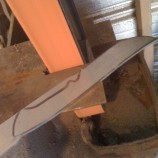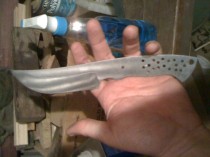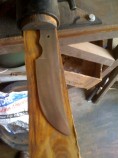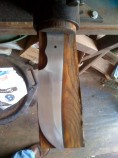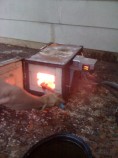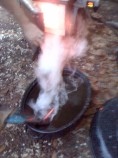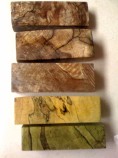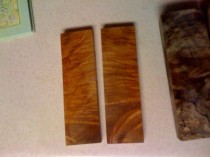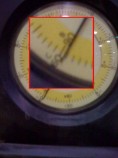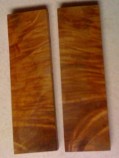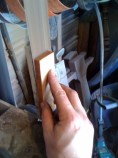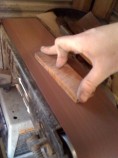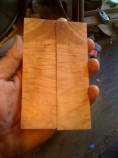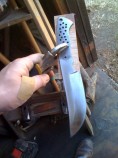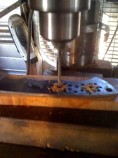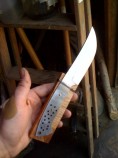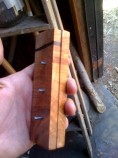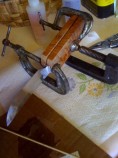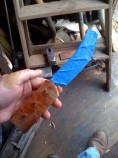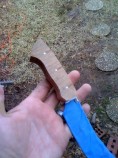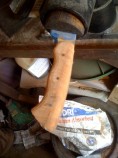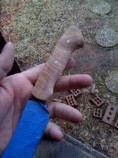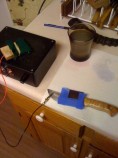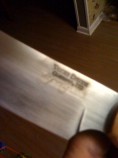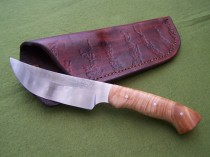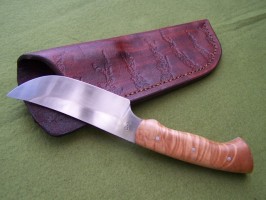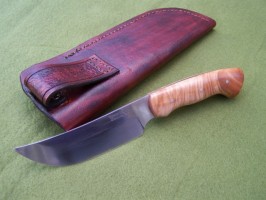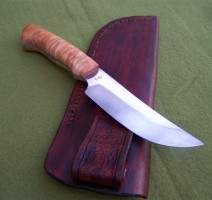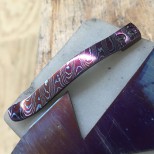Work In-Progess
03/20/2010
In this picture you can see that I've further ground the bevels and flats. I've also drilled the holes for the handle pins and a hole for the thong tube (if the customer so desires a thong hole). You can see where I've drilled quite a few holes towards the rear of the handle to reduce the handle weight. This will result in a knife that's better balanced in the hand.
03/23/2010
Ok, so now I've clamped the blade, along with a thin piece of osage orange for support, into my knife vise. I'll start with some 220 grit waterproof sandpaper that is wrapped around a small piece of marble. This will help keep the flat areas flat, without rounding over the grind lines. I also keep the blade spritzed with either Windex or WD40. This helps keep the grits from clogging the sandpaper and also produces a finely-gritted slurry that also helps in polishing the blade. You can use many different liquids to achieve this; some use different types of oils, water, etc.
03/23/2010
It's about 30 minutes later and this side of the blade is mostly done with the 220 grit sandpaper. There are still some scratches to be removed, though, so I'll pick back up here tomorrow, after I pick up some more sandpaper :)
It's starting to have that nice, hand-rubbed finish, though, and once I take it through the higher progressions of grits, to 320, 400, 600, and then 1000, it will have a very, very nice finish. I'll only take it to about 400 now, before heat-treat.
03/24/2010
Ok, went by the hardware store and purchased mucho sandpaper... No pictures of finishing the hand-sanding, just more of the same. Back and forth, back and forth.
03/24/2010
Here I'm quenching the blade. I'm using a quench oil from McMaster-Carr. I dip the blade in, edge first, as if I'm "cutting" into the oil. Up and down, and forward and backwards motions only. Absolutely no side to side motion while in the quench, since that can contribute to warpage in the blade.
Now it's off to the oven for a couple of two hour tempers!
Tomorrow I'll clean up the blade and then have the hardness tested. Then it's time to start picking out the wood for the handle.
03/27/2010
Now I've put a few drops of super-glue on the handle and clamped the scale to it. I'll let it set for about 10 minutes to make sure there's a pretty good bond. This isn't the final bonding for the handle, just something to hold the scale in place on the handle while I drill the holes for the pins. Once I'm finished drilling the scale, the scale will pop off with just a little knock against the bench.
03/27/2010
Now I put the pins into the scale, then lay the blade onto the scale using the pins as guides. I have to mark where to grind the scale down to and get the front edge of the scales finished before final attachment. Otherwise, there's no good way to finish the front edge of the scales once they're attached.
03/27/2010
I cleaned the handle with acetone to make sure it's good and clean, and also lightly went over the scales, too. Then, I mixed the epoxy, applied it to the handle, and put on the scales. I used clamps to hold it tightly, but not super tight. I don't want to squeeze all of the epoxy out.
You'll notice that there's something white on the blade just in front of the scales. I dry-fit the scales to the blade before epoxying them, and applied a little bit of balmex to the front edge. You can also use petroleum jelly, etc., whatever will keep the epoxy from sticking. This makes cleanup after the epoxy has dried MUCH easier.
The epoxy sets up pretty quickly, but I like to wait overnight before I work with the scales just to make sure everything is good and set up before I start shaping the handle.
03/28/2010
Here the knife is shown in the knife vise. You can see that I've put some of the initial shaping on the handle. I'll twist it around and work on each side until I'm happy with how it fits in my hand. The finish of the handle will be very rough at this point, so once I'm done rough-shaping the handle, I'll take it to the grinder with a 120 grit belt. This will put a much smoother finish on the handle and make it ready to start hand-sanding.
03/30/2010
I finished the handle, so now it's time to etch my logo into the blade. The black box in the picture is a homemade etching unit (thanks to plans by Chris Crawford). The glass contains hot saltwater, and I'll dip the felt-covered electrode in the saltwater and dab it onto the stencil about 20 times. The saltwater completes the circuit and etches the design through the stencil. In case anyone is wondering, I get my stencils from Ernie Grospitch, great service and product.

